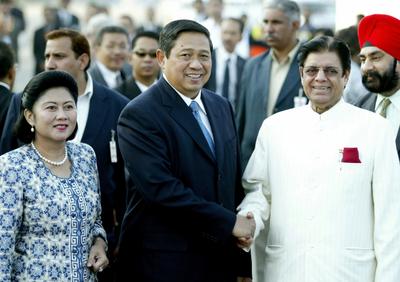This was an association that tried to promote cooperation around the region itself. But it has never gone very far.
In the middle of last decade, diplomatic flirtation with the idea that a new quadrilateral alliance in Asia and the Pacific centred on India’s anchor role, with the United States, Japan and Australia, in a soft, ‘values-based’ containment initiative (the Quad Initiative) directed at strategic encirclement of China blossomed briefly and seemed to fade from public view, as noted before in these columns. This idea sought to bring powers from outside the Indian Ocean region into strategic alliance with India on a mission directed at dealing with the rise of China. The retreat from the Quad idea coincided with Abe’s loss of power in Japan.
Underneath the surface, the Quad idea was not dead. But India, and China, not unexpectedly, have moved on.
In this week’s lead essay, Sourabh Gupta examines India’s relations with Indonesia. Gupta observes that ‘to this day, both India and Indonesia hold strong preferences for multilateral and UN-centered cooperation and an unfavorable view of close-ended, collective security arrangements.’ But ‘that said, both countries have not been beyond deviating from these principles at moments of strategic opportunity or exigency.’ Both countries have framework defense cooperation agreements with Western partners, the United States and Australia, respectively. Yet ‘as the post-Cold War geo-political canvas of Asia once again bears the flux and promise reminiscent of the early post-independence period, both countries – independently – remain wedded to policies that reinforce their cherished strategic latitude.’
Yet, Gupta bemoans, for all their parallel histories, similar policy preferences and receptivity to independent-minded partnerships in Asia, the interaction between New Delhi and Jakarta has been remarkably unenthusiastic and inactive since the inauguration of their New Strategic Partnership, five years ago. Prime Minister Manmohan Singh and President Susilo Bambang Yudhoyono remain culpable, he says, of a failure to inject content to their bilateral relationship.
And, Gupta reminds us, there are opportunities to develop a more ambitious set of goals for the partnership: through an initiative by India to invite Indonesia into the BRIC grouping, through Indonesia’s inviting Indian naval cooperation in patrolling the Straits of Malacca, and through more broadly based regional economic cooperation.
As he also warns, there are cautionary tales from their falling out in the past that need to be remembered. In the past, as now, China was the common denominator over which India and Indonesia tied themselves in knots.
Going forward, attempts to cast the relationship on a China constrainment pillar are equally likely to be founded on each nation’s different margins of security vis-à-vis Beijing – the overlapping Chinese claim to a gas-rich corner of Indonesia’s EEZ will be overshadowed by India’s eyeball-to-eyeball proximity along its undefined boundary line with China. Proactive efforts of both to co-opt Beijing, bilaterally, by way of a military-to-military dialogue or attempts to forge a sub-regional code of conduct in the South China Seas, are, Gupta points out, considerably more advanced in Jakarta than in New Delhi. Gupta notes in this regard that the two PLA anti-piracy patrol warships, the recent docking of which at Yangon port caused angst in New Delhi, subsequently dropped anchor in the Indonesian archipelago.
India, Indonesia and China are three powers with common borders, each with their own vulnerabilities, all with inexorably growing economic and shared interest objectives in global governance, all with the need to deal with each other’s growing power in its own Asian space. Engaging with China bilaterally is an imperative for India; for Indonesia, this is not an option.
While there is, as Gupta suggests, much scope for cooperation between India and Indonesia across the range of regional economic and security issues, there would seem little foundation for a regional strategy that would seek to count China out.

